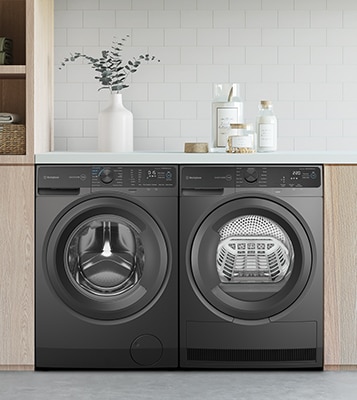1. Choosing The Right Washing Machine For You
There are plenty of things to consider when purchasing a new washing machine. You might be thinking about the dimensions to fit into your space, types of cycles and capacity for your household. This front loader buying guide allows you to discover the best washing machine for your family's needs.
FRONT-LOADER OR TOP-LOADER?
When it comes to choosing between top-loader and front-loader washing machines, there are benefits to each.
Front-loader washing machines are gentler on clothes, given that gravity does half of the work in moving laundry around the drum, and can typically accommodate larger loads than top loaders. They also provide a superior clean in terms of stain removal and are more water and energy efficient than their top-loader siblings.
Considering a top-loader? View our top-loader washing machine buying guide here.

2. Space
Consider the space in which the washing machine will sit - is there room to easily open the door in order to load laundry in? Is a stacking system a better option for the space, where you can position your dryer on top of your washing machine? Having your front-loader washing machine positioned next to a sink makes for easy transfers when soaking stained items, and a shelf within easy reaching distance means less potential for messy spills with detergents and fabric softener.
The average dimensions of a smaller front-loader washing machine are about 850mm(H) x 600mm (W) x 575mm (D), whereas a larger model averages around 850 (H) x 600mm (W) x 660mm (D), so in terms of size variation you can afford to have a larger model in a similar space.

3. Size
|
Household size |
Dryer capacity (kg) |
|
2-3 people |
7.5kg |
|
3-4 people |
8kg |
|
4-5 people |
9kg |
|
5-6 people |
10kg |


4. Water Efficiency
Choosing low water levels instead of high, and ensuring you do full loads instead of smaller loads can make the best use of your water supply. The Water Efficiency Labelling and Standards (WELS) scheme is an Australian government initiative that helps consumers understand the way their whitegoods use water through labels that convey vital information.
The star rating at the top correlates with how water-efficient a product is, and can be used to compare across different models. These labels will also list the product’s rate of water consumption, which on a washing machine correlates with the litres of water used per wash, and the load capacity of the machine.

5. Energy Efficiency
Likewise, Australia’s Energy Star-Rating scheme allows consumers to compare their products with similar models to understand how much energy they consume. The more stars, the more energy efficient a product is. All Westinghouse front-loader washers have an energy star-rating of above 3.5, with most in the range achieving a 4 or 5. In addition to this, choosing a front-loader washing machine can allow you to save up to 70 percent on energy usage with each load.
All Westinghouse front-loader washing machines include a range of features allowing you to control the amount of energy consumed in a wash cycle, including ‘cold’, 30, 40, 50, 60 and 90 degree wash options, giving consumers the ability to choose according to their needs for individual wash cycles.

6. Speed
All Westinghouse front-loader washing machines come with six spin-speed options: 1200rpm, 800rpm, 600rpm, 400rpm, Rinse Hold and None. You should always choose the highest spin speed that is appropriate for the weight and type of laundry load.
For example, lower spin speeds are best for delicate or lightweight fabrics, as this can protect garments. Higher spin speeds are perfect for denim or towels that need additional wringing out before drying.


7. Wash Cycles And Programs
|
Full Load 60 |
Our Full Load 60 lets you wash an entire load in 60 minutes – see Full Load 60 video – less time than it takes to play a game of Monopoly – and without compromising on wash results. |
|
Fast 15 |
If washing that top that’s not dirty enough for the laundry basket, but not clean enough for the cupboard has slipped your mind, our Fast 15, a quarter hour wash, can refresh any urgent items you might need. |
|
Daily 39 |
When you’re looking to create more hours in your day, our Daily 39 delivers the kind of quality wash you expect for light loads, in less time – 39 minutes to be exact. |
|
Plus Hygiene |
Where there are kids, there are germs – and a hygienically clean laundry is more important than ever. Our Plus Hygiene function uses vapours to neutralise 99.9%* of selected common household allergens & bacteria |
|
Delicate cycle |
We haven't forgotten about your favourite items that you wear on special occasions. With our delicate cycle, you can trust your clothes will be protected and cleaned without any worry. |
8. Care Considerations
There is also a mesh cover at the end of the drain hose which can become clogged over time; as such it’s a good idea to remove and clean it regularly.







